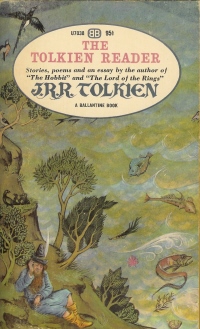This is a list of all published works of the English writer and philologist J. R. R. Tolkien. Tolkien's works were published before and after his death.
Unless stated otherwise, the years indicate the date of composition.
A large volume of Tolkien's writings on his constructed languages, primarily the Elvish languages such as Quenya and Sindarin, was published and annotated by scholars in the journals Vinyar Tengwar and Parma Eldalamberon .

The Cirth is a semi‑artificial script, based on real‑life runic alphabets, one of several scripts invented by J. R. R. Tolkien for the constructed languages he devised and used in his works. Cirth is written with a capital letter when referring to the writing system; the letters themselves can be called cirth.

The Tengwar script is an artificial script, one of several scripts created by J. R. R. Tolkien, the author of The Lord of the Rings.
The Elvish languages of Middle-earth, constructed by J. R. R. Tolkien, include Quenya and Sindarin. These were the various languages spoken by the Elves of Middle-earth as they developed as a society throughout the Ages. In his pursuit for realism and in his love of language, Tolkien was especially fascinated with the development and evolution of language through time. Tolkien created two almost fully developed languages and a dozen more in various beginning stages as he studied and reproduced the way that language adapts and morphs. A philologist by profession, he spent much time on his constructed languages. In the collection of letters he had written, posthumously published by his son, Christopher Tolkien, he stated that he began stories set within this secondary world, the realm of Middle-earth, not with the characters or narrative as one would assume, but with a created set of languages. The stories and characters serve as conduits to make those languages come to life. Inventing language was always a crucial piece to Tolkien's mythology and world building. As Tolkien stated:
The invention of languages is the foundation. The 'stories' were made rather to provide a world for the languages than the reverse. To me a name comes first and the story follows.
The English philologist and author J. R. R. Tolkien created several constructed languages, mostly related to his fictional world of Middle-earth. Inventing languages, something that he called glossopoeia, was a lifelong occupation for Tolkien, starting in his teens.

The Adventures of Tom Bombadil is a 1962 collection of poetry by J. R. R. Tolkien. The book contains 16 poems, two of which feature Tom Bombadil, a character encountered by Frodo Baggins in The Lord of the Rings. The rest of the poems are an assortment of bestiary verse and fairy tale rhyme. Three of the poems appear in The Lord of the Rings as well. The book is part of Tolkien's Middle-earth legendarium.
Tolkien fandom is an international, informal community of fans of the works of J. R. R. Tolkien, especially of the Middle-earth legendarium which includes The Hobbit, The Lord of the Rings, and The Silmarillion. The concept of Tolkien fandom as a specific type of fan subculture sprang up in the United States in the 1960s, in the context of the hippie movement, to the dismay of the author, who talked of "my deplorable cultus".
The following outline is provided as an overview of and topical guide to the real-world history and notable fictional elements of J. R. R. Tolkien's fantasy universe. It covers materials created by Tolkien; the works on his unpublished manuscripts, by his son Christopher Tolkien; and films, games and other media created by other people.
The term Middle-earth canon, also called Tolkien's canon, is used for the published writings of J. R. R. Tolkien regarding Middle-earth as a whole. The term is also used in Tolkien fandom to promote, discuss and debate the idea of a consistent fictional canon within a given subset of Tolkien's writings.
The Elvish Linguistic Fellowship is a "Special Interest Group" of the Mythopoeic Society devoted to the study of J. R. R. Tolkien's constructed languages, headed by the computer scientist Carl F. Hostetter. It was founded by Jorge Quiñónez in 1988.
Carl Franklin Hostetter is a Tolkien scholar and NASA computer scientist. He has edited and annotated many of J. R. R. Tolkien's linguistic writings, publishing them in Vinyar Tengwar and Parma Eldalamberon.
The works of J. R. R. Tolkien have generated a body of research covering many aspects of his fantasy writings. These encompass The Lord of the Rings and The Silmarillion, along with his legendarium that remained unpublished until after his death, and his constructed languages, especially the Elvish languages Quenya and Sindarin. Scholars from different disciplines have examined the linguistic and literary origins of Middle-earth, and have explored many aspects of his writings from Christianity to feminism and race.

The Tolkien Reader is an anthology of works by J. R. R. Tolkien. It includes a variety of short stories, poems, a play and some non-fiction. It compiles material previously published as three separate shorter books, together with one additional piece and introductory material. It was published in 1966 by Ballantine Books in the USA.

The Homecoming of Beorhtnoth Beorhthelm's Son is a work by J. R. R. Tolkien originally published in 1953 in volume 6 of the scholarly journal Essays and Studies by Members of the English Association, and later republished in 1966 in The Tolkien Reader; it is also included in the most recent edition of Tree and Leaf. It is a work of historical fiction, inspired by the Old English poem The Battle of Maldon. It is written in the form of an alliterative poem, but is also a play, being mainly a dialogue between two characters in the aftermath of the Battle of Maldon. The work was accompanied by two essays, also by Tolkien, one before and one after the main work. The work, as published, was thus presented as:

Quenya is a constructed language, one of those devised by J. R. R. Tolkien for the Elves in his Middle-earth fiction.
Sindarin is one of the constructed languages devised by J. R. R. Tolkien for use in his fantasy stories set in Arda, primarily in Middle-earth. Sindarin is one of the many languages spoken by the Elves. The word Sindarin is a Quenya word.
Arden Ray Smith is a member of the Elvish Linguistic Fellowship and holds a Ph.D. in Germanic Linguistics from the University of California, Berkeley. He has published numerous articles relating to the languages constructed by J. R. R. Tolkien. He was a columnist and editor of Vinyar Tengwar, for which he wrote the popular column "Transitions in Translations", in which odd elements in translations of Tolkien's work were described and commented upon.
Quenya is a constructed language devised by J. R. R. Tolkien, and used in his fictional universe, Middle-earth.

Tolkien's Art: 'A Mythology for England' is a 1979 book of Tolkien scholarship by Jane Chance, writing then as Jane Chance Nitzsche. The book looks in turn at Tolkien's essays "On Fairy-Stories" and "Beowulf: The Monsters and the Critics"; The Hobbit; the fairy-stories "Leaf by Niggle" and "Smith of Wootton Major"; the minor works "Lay of Autrou and Itroun", "The Homecoming of Beorhtnoth", "Imram", and Farmer Giles of Ham; The Lord of the Rings; and very briefly in the concluding section, The Silmarillion. In 2001, a second edition extended all the chapters but still treated The Silmarillion, that Tolkien worked on throughout his life, as a sort of coda.
Finnish influences on Tolkien include both the Finnish language, which he especially liked, and the epic poem Kalevala, a 19th century compilation of Finnish mythology by Elias Lönnrot, which Tolkien stated had powerfully affected him. He further stated that his invented Elvish language of Quenya was influenced by the phonology and structure of Finnish.